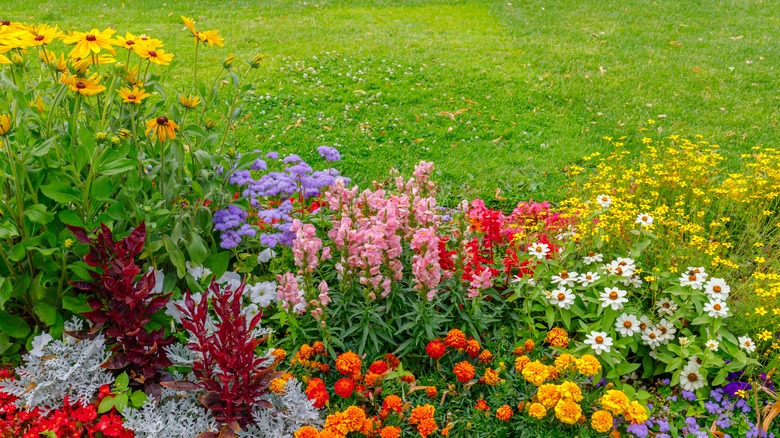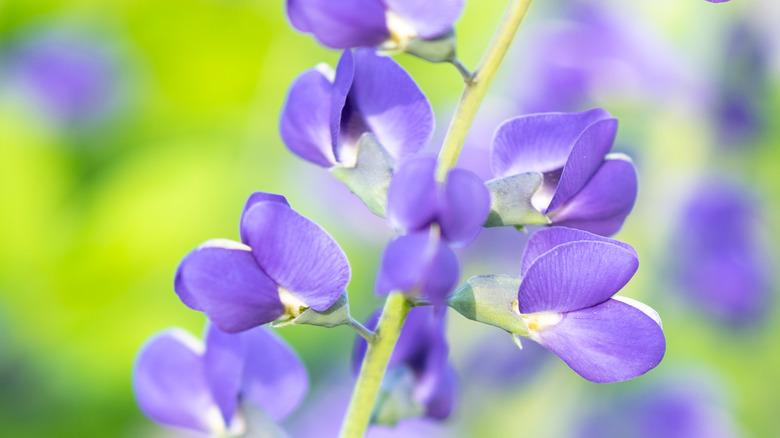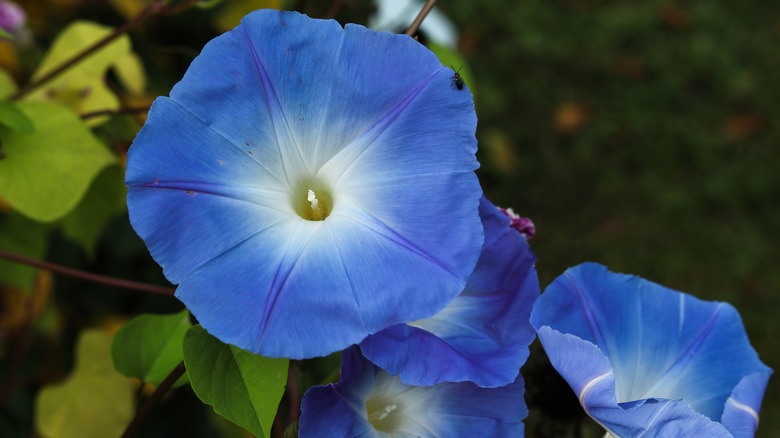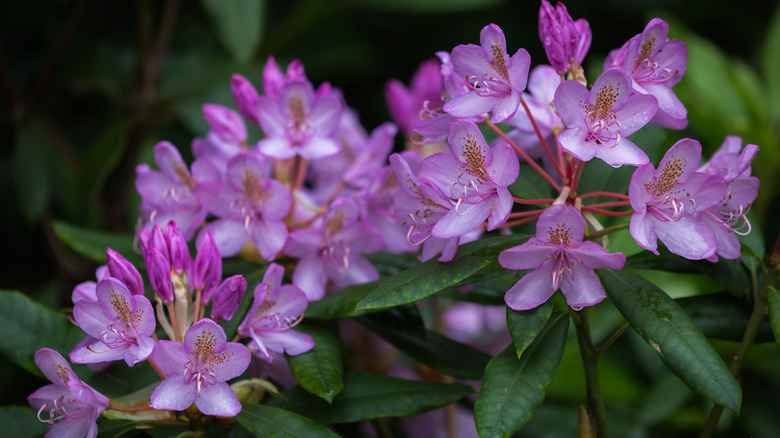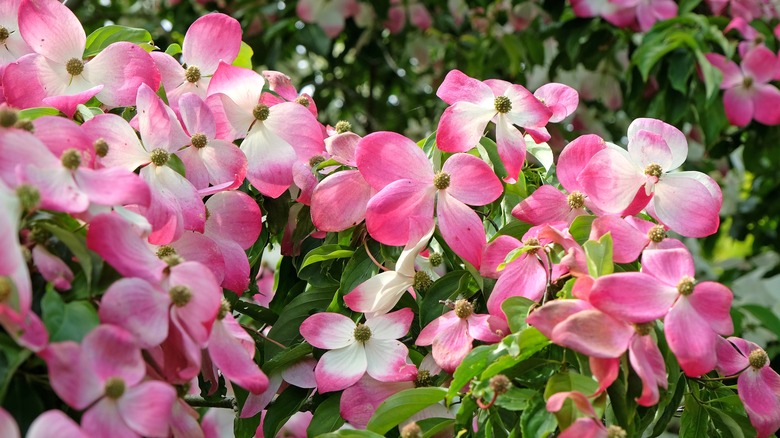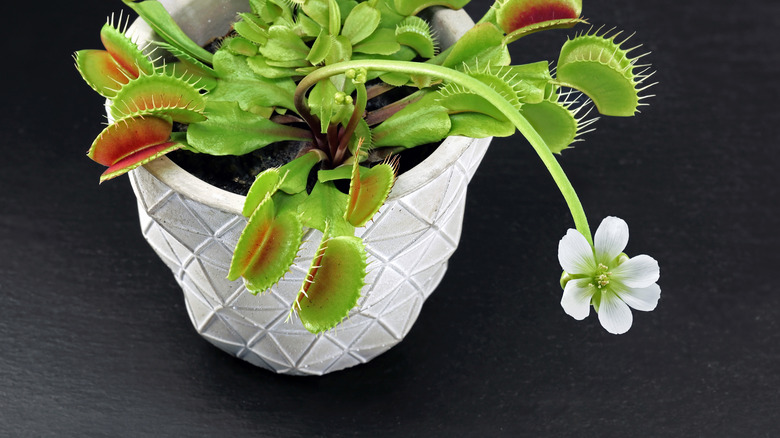Flowers That Grow Best Without Commercial Fertilizer
Your garden is an oasis. Whether it's indoors or out in the yard, a collection of plants provides a much-needed respite from all things urban and human-made, and quickly transports you to a more natural, calming setting. But if you're living a fast-paced life, you may simply lack the time to tend to all your leafy babies' needs — especially those like nutrition, which varies widely between plants and may require you to follow a set fertilization schedule. Without adequate fertilization, many plants will lack the nutrients to grow well, bud, and produce flowers. So how do you fit gardening into a busy, modern lifestyle? One answer is to opt for low-maintenance flowers that don't need commercial fertilizer.
Finding plants that thrive without store-bought plant food shouldn't be difficult. Look around you — the parks, forests, meadows, and other natural areas near you are home to a tremendous assortment of plants that get by just fine without being fed by humans. That's because these native species like false indigo and dogwood trees get all the elements they need for healthy growth right from the natural soil. There are plenty of perennial, shrub, and tree options you can plant in the yard that will find the nutrients they need without much assistance, and some even dislike rich soils. Most annuals and houseplants need a bit more help from their humans when it comes to nutrition, but even these plant categories have a few outliers that prefer to feed themselves.
Perennial flowers that require no additional fertilizer
If you're looking for garden flowers that don't need commercial fertilizer to thrive, you'll find an assortment of options among herbaceous perennials. Generally, perennials don't need supplemental nutrition if they grow in healthy soil, especially if they're native to the region. In fact, fertilizing some of these plants may cause more harm than good, as they respond to the extra nutrition by growing extremely tall, then flopping over.
For example, false indigo (Baptisia australis) is nitrogen-fixing and does not need additional plant food. It's hardy anywhere in USDA zones 3 through 9, but is native to the Eastern half of North America. Likewise, native North American asters (Symphyotrichum and Eurybia) thrive with minimal maintenance and without commercial fertilizer in USDA zones 4a to 8b. If you want to add a touch of lively orange to your garden, consider butterfly weed (Asclepias tuberosa). These herbaceous perennials are native to most of North America apart from the Pacific Northwest, and flourish with no additional nutrition in zones 3 through 9. Their only request is that the soil — regardless of type — drains well.
If you grow these perennials in particularly poor soil, a bit of compost applied when planting should supplement their nutritional needs. All you need to do is topdress the plants with a layer of compost after planting. However, be sure to research the nutritional needs of the individual species, as even the compost may not be beneficial.
Annuals that grow well without added commercial fertilizer
Annuals are generally heavier feeders than their perennial counterparts. Partly, that's because many annuals come from tropical regions where they grow year-round, but only survive the warmer seasons north of the tropics. Outside of their native habitat, these plants become voracious feeders because the soil isn't as nutrient-dense or moist. To compensate for this environmental difference, you have to provide sufficient quantities of organic matter and commercial fertilizer to keep annual flowers growing vigorously and blooming through the season.
That said, there are still a few fertilizer-averse flowers that we grow as annuals in North America. Morning glory (Ipomoea) is one example. These flowering vines will grace your trellis or fence, as long as you grow them in warm, sunny locations and well-draining soil. They don't need any fertilizer to grow or bloom, and actually have a preference for poor soil. Moonflowers (Ipomoea alba) belong to the same family as morning glories and share many of the latter's characteristics. These vines hail from Central America, but also grow as annuals in the warmer regions of the U.S., and, like their morning glory cousins, they don't like supplemental nutrients in the soil. You'd have to grow these vines on a trellis or any other type of vertical support in a sunny location. Although they're not particular about soil conditions, the growing medium should shed excess water well.
Flowering shrubs that thrive without fertilizer
Most flowering shrubs do not need fertilizer for blooms or healthy growth. This is especially true for plants grown in their native habitat and those that have reached maturity. Even young plants can suffer from a well-intentioned fertilization program, as the additional nitrogen can suppress root growth as the plant is getting established.
For example, rhododendrons and azaleas grow just fine without additional plant food, as long as they're planted in nutrient-rich soil. These plants are hardy in USDA zones 4a to 9, but if the rhododendron bush you're planting is a non-native species or you're not sure whether the soil in your yard is suitable for the variety, you should perform a soil test before adding any fertilizer. Note that some rhododendron varieties can suffer serious damage to roots and leaves, or even die when fertilizer is added to their growing medium.
Chokeberry (Aronia arbutifolia) is another example of a flowering shrub you can grow without giving it any commercial fertilizers. In your garden, red, black, and purple chokeberries will make an appealing addition as shrub borders, hedges, or screens. These shrubs thrive in a wide range of climates spanning between USDA zones 3a and 9b. They do well in many different soil types and even tolerate some standing water. While no chemical fertilizer is needed for chokeberry shrubs to grow and stay healthy, you can mulch around the plants with a layer of compost to give them a nutritional boost.
Flowering trees that don't need to be fed
Much like shrubs, most established trees planted in a suitable medium do not need commercial fertilizer to flourish. Younger trees also stand the risk of getting their roots damaged from fertilizer applied during planting, and interestingly, they're able to absorb a portion of the nutrition you give to nearby turf. Instead of fertilizing the young plantings, you should focus your efforts on adequately irrigating them.
Although most trees get by without store-bought plant food, we'll still list a few ornamental tree species that are particularly well-suited for a fertilizer-free life. Flowering dogwood (Cornus florida) is a prime example. This gorgeous understory tree produces plentiful, luxuriant white or pink blooms in the spring, and is hardy in zones 5a through 9b. For best results, grow dogwood trees in moist soil that drains well. The soil does not need any fertilizer if it's rich in humus, and slightly acidic.
Cherry blossoms are a favorite springtime attraction in many parts of the globe, and planting cherries in your yard likewise means that you won't need to use artificial fertilizer. Before you plant a cherry in your yard, be sure to pick out a spot with rich soil that doesn't retain water. When planting, mix lots of compost with the soil before placing the root ball into the hole. This organic nutrition will help the tree get established. Once the cherry tree matures, it won't need much attention beyond pruning and keeping insects away.
Houseplants that don't like fertilizer
Houseplants grow in pots, which limits access to nutrients. It may be obvious, but potted flowers can't tap into the wealth of nutrients present in the soil the way garden plants do. Many houseplants suffer from micronutrient deficiencies, and also lack elements such as magnesium, as it leaves the potting soil along with water draining out of the holes. To correct these nutritional imbalances and promote new growth in most indoor plants, you need to add commercial fertilizer to their growing medium.
Intriguingly, there is a group of flowers that are often grown in containers indoors that don't live by the same rules. They're known as carnivorous plants, and include species such as the Venus fly trap (Dionaea muscipula), which traps insects with its hinged leaves and has white flowers that bloom from May to June. Pitcher plants (Sarracenia rubra) and butterworts (Pinguicula) are also flowering carnivorous plants. These plants get their nutrients from insects that they trap with their leaves, not from the soil. In fact, adding nitrogen to the soil can burn these plants' traps, ironically ridding them of a means to feed themselves. For some carnivorous varieties, such as butterworts, soil fertilizers present a real danger, as they can cause severe root damage. Instead of trying to feed these carnivorous species with a food that may harm them, give them access to a source of nutrition they love — insects. Wingless and flightless fruit flies are an excellent choice.
